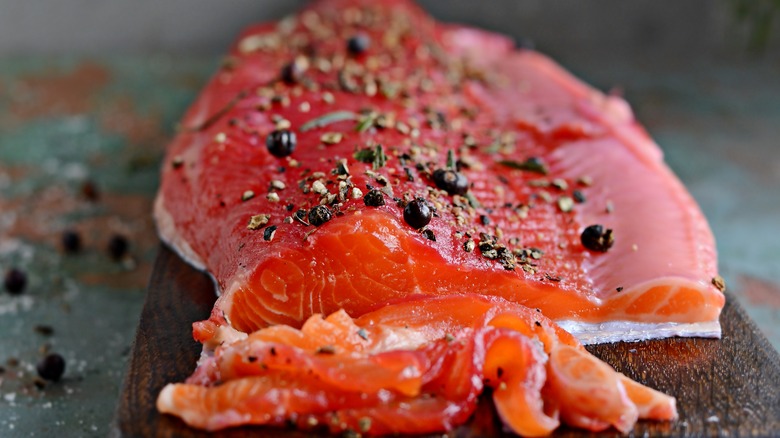The Unexpected Way Ina Garten Cures Salmon
Curing foods by rubbing or injecting them with a salt mixture and letting that salt do its magic over a period of time is a very popular way of preserving throughout the world (via The Seattle Times). For many of us, "salted and cured" might conjure up visions of delightful charcuterie boards with bits of dried ham and sausages artfully arranged with cheese, bread, and a nice glass of wine. Ina Garten is no stranger to that sort of platter, especially given her expertise as both a cook and party planner (per Barefoot Contessa). But curing isn't only for meats. It's a process that is used with fish as well, particularly in parts of the world where fish is abundant and winters are long.
Curing isn't just for professionals and butchers, either. Adventurous home cooks can easily do it themselves in their own kitchen. Naturally, Garten, the hostess with the mostess, has quite a recipe for home-cured salmon (via Food Network). Curing fish often involves some form of high-proof-alcohol, since alcohol boosts flavor as well as helps prevent the growth of bacteria. The list of ingredients isn't long, though. In addition to a three-pound piece of fish cut into two large fillets, Garten uses Pernod (which has a mild anise flavor), fresh dill, salt, peppercorns, and fennel seeds to coat the salmon. After coating the fish with the dry and wet ingredients, she wraps it in plastic wrap.
That's when things take an unexpected twist.
Ina Garten takes cans to a whole new level
Once that fish is good and soaked, it needs some pressure in order to cure properly. But most of us don't have industrial machines lying around the house to do the job. What's a Barefoot Contessa to do? Can it — literally. Garten recommends putting the wrapped salmon in a deep dish and then taking a number of heavy cans (which, presumably, you already have somewhere around), using them to weigh down the fish as it cures. You let the fish sit for two to three days so that time, salt, and spirit can do their work (via YouTube).
While the fish is curing, you flip the sides several times to keep things evenly distributed, but there's not much more to it. After the time is completed, you unwrap the fillets, scrape off most of the herbs and seasonings, and slice thinly (per Food Network). Garten suggests layering the delicate pink morsels on mini pumpernickel bread triangles which have first been smeared with Gravlax sauce, a tangy mixture of mustards, seasoned with some salt, sugar, vinegar, and dill.
The salmon can cure sounds like it could bring a little excitement to your appetizer repertoire or your Sunday brunch. Who needs to cook when you can cure?

